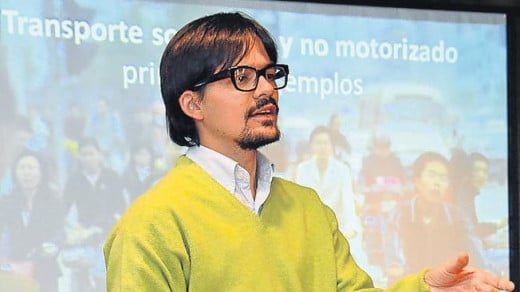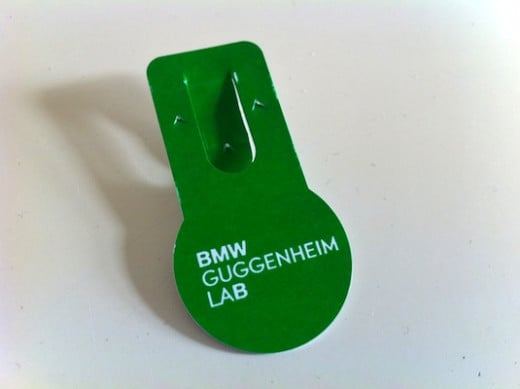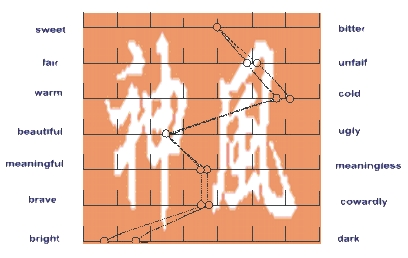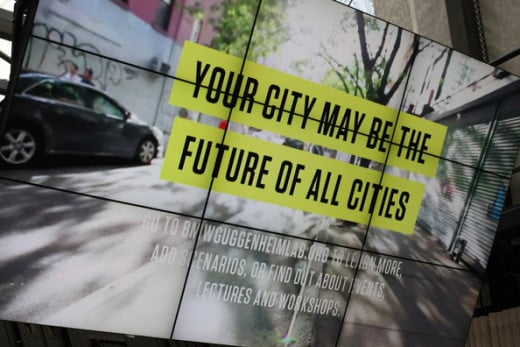Commuting Psychology Tour with CarlosFelipe Pardo from BMW Guggenheim Lab in NYC Fall 2011
Carlos Felipe Pardo


Introduction
This is a brief report on the Transit Psychology Tour, an event that was part of BMW’s Guggenheim Lab in the fall of 2011. The event was conducted by CarlosFelipe Pardo, the Director of Slow Research (http://slowresearch.org/). The aim of this event was to determine the success of New York City’s multimillion-dollar transportation authority – the Metropolitan Transportation Authority. One might ask if the need for efficient travel has overruled quality of transport. Is the MTA’s definition of success skewed?
CarlosFelipe Pardo takes on these questions. As a transit psychologist he is investigating how cities model public transit systems on "comfortable transportations" such as walking and cars. Comfortable transportations are a form of transport where one has control of their mode of transportation. This event looks into how New York City can improve the subway system by taking what we know about comfortable transportations and adapting it to the MTA mass transit. In a city that places a high value on mass transit, with multiple modes of transportation, it may lead one to question why there are traffic jams of all types almost constantly. People prefer to use their cars because they are more comfortable, they have more control, and their personal space is defined. We’ll examine whether this holds true for public transportation system in New York City.
Semantic Differential Survey

The Event
Meeting at the Solomon Guggenheim Museum at 89th street, the group of attendees took the train (6th local to Union Square) and walked from Union Square to the BMW Guggenheim Lab. After they arrived at the BMW Lab, the group first thought about their subway experience. Using coloring utensils, they were asked spontaneously to draw on a sheet what they remembered from walking down the stairs into the subway and getting out at Union Square. Then the group proceeded to draw the walking portion of the trip, followed by a semantic differential survey on both experiences. Semantic Differential Analysis takes survey of usually two opposite ideas and creates a visual representation of the data using a scale of two bipolar adjectives. The survey used various terms to elicit user’s experience regarding different modes of transportation. “Sad, happy, slow, fast, aesthetic , unaesthetic, beautiful, ugly, new, old, comfortable, uncomfortable, varied, monotonous, complex, simple, difficult, easy, colorful, colorless, long, short, near, fair, playful, serious, unexpected, expected, interesting, dull, place, non-place, thoughtful and thoughtless..” These options on the survey helped mark different human emotions and provided a scale to determine the depth of feeling into each emotion. This analysis showed how people felt when they travelled in one mode of transport or other. People generally expressed their desire for more control in their environments. That seems like an obvious idea but it is naively looked upon because other factors like cost, less travel time etc. are given more precedence. Walking was the favored mode of transportation compared to the train in almost all categories. So in happy-sad, users felt happier from walking than sitting on a still position or standing in a fixed position on the train. This data is supported by medical knowledge that states that when your body is in action, blood actively circulating and your brain is much more engaged. This is in contrast to no activity which results in less engagement and activity in the brain and subsequently less happiness. In the survey results, the attendees agreed on one thing, in both walking and subway use; the sense of delayed to punctual spectrum was the same. This can support that claim that being more stimulated by what one sees, or thinking about something (ads, passing pedestrians, cars), does not detract from the sense of feeling delayed or punctual. Additionally the survey found that walking was more simple (on a simple/complex scale) than the subway, and walking was seen as easier than the subway. These answers were all average survey results of the group, and it highlights the need for the MTA to maintain an active discussion with New Yorkers who use their services just as there is an active discussion between the pedestrians and cars in creating shared spaces. The data collected from the survey agreed with CarlosFelipe’s initial proposition that when you give importance to the quality of the transit systems, you can expect more users. CarlosFelipe argues that until people start offering experiences that are more appealing than cars, it will be difficult to convince those drivers to use the subway system. CarlosFelipe’s efforts to try to bring awareness to user experiences on the subway and applying knowledge of comfortable transportation system to the mass transit system may ultimately require changing the trains and buses altogether. With respect to this knowledge, the train with its current design, based on 19th century rail lines, may need to undergo a radical change in the near-distant future. Trains are seen as a medium to minimize travel time, “the train was experienced as a projectile, and traveling on it, as being shot through the landscape” (Schivelbusch, 1983). A participant in the tour noted “I felt oblivious sitting in the train and only recall walking into the train and getting out, as notable, whereas walking I can remember pointing out several things to people I was walking with..”

Conclusion
To summarize CarlosFelipe’s goals are universally agreeable, we have to improve our commutes. It starts with keeping in mind psychologically that human beings are not boxes being moved from one place to another but people desiring to move comfortably from one place to another. This event relates to the overall theme of urban design because it involves the design of spaces: the transformation of an urban space into a social space. The conclusion is that there needs to be a framework to facilitate successful dialogue between the average user and the entity managing the system. This event promoted the urban design principles of improving quality of the public realm and inclusivity. It is an example of a problem that needs to be addressed according to Kevin Lynch five performance dimensions: Vitality - the degree to which the public transit supports the function of its use, Sense - the degree to which trains/buses are perceived by its users, Fit - the degree to which New Yorkers can engage in that environment, Access - how well New Yorkers can interact with other users, and Control - degree to which one can control their environment.
Reference:
Schivelbusch, W. (1979) The Railway Journeys: Trains and Travel in the 19th Century (Oxford: Blackwell).
BMW Guggenheim Lab - Transit Psychology Tour
Cite this page
MLA Format
Soman, Stanley. "Commuting Psychology Tour with CarlosFelipe Pardo from BMW Guggenheim Lab in NYC Fall 2011." Expertscolumn on HubPages. HubPages, 25 Dec. 2012. Web. 27 Dec. 2012 (Replace with the date of your access). <http://expertscolumn.hubpages.com/hub/Commuting-Psychology-Tour-with-CarlosFelipe-Pardo-BMW-Guggenheim-Lab>.
APA Format
Soman, S. (2012, December 25). Commuting Psychology Tour with CarlosFelipe Pardo from BMW Guggenheim Lab in NYC Fall 2011. Expertscolumn on HubPages. Retrieved December 27, 2012 (Replace with the date of your access), from http://expertscolumn.hubpages.com/hub/Commuting-Psychology-Tour-with-CarlosFelipe-Pardo-BMW-Guggenheim-Lab






